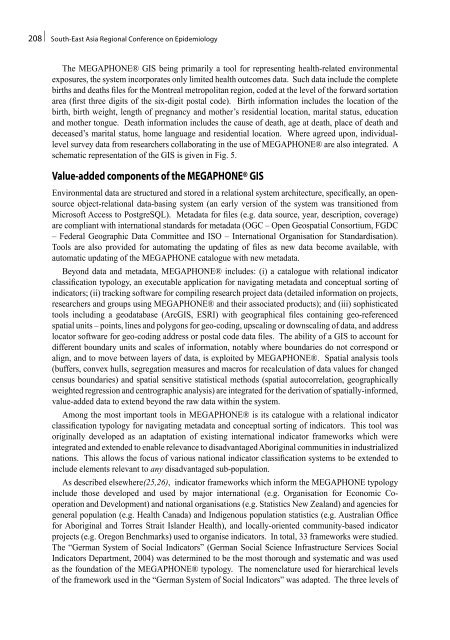South-East Asia Regional Conference on Epidemiology
South-East Asia Regional Conference on Epidemiology
South-East Asia Regional Conference on Epidemiology
Create successful ePaper yourself
Turn your PDF publications into a flip-book with our unique Google optimized e-Paper software.
208 | <str<strong>on</strong>g>South</str<strong>on</strong>g>-<str<strong>on</strong>g>East</str<strong>on</strong>g> <str<strong>on</strong>g>Asia</str<strong>on</strong>g> <str<strong>on</strong>g>Regi<strong>on</strong>al</str<strong>on</strong>g> <str<strong>on</strong>g>C<strong>on</strong>ference</str<strong>on</strong>g> <strong>on</strong> <strong>Epidemiology</strong><br />
The MEGAPHONE® GIS being primarily a tool for representing health-related envir<strong>on</strong>mental<br />
exposures, the system incorporates <strong>on</strong>ly limited health outcomes data. Such data include the complete<br />
births and deaths files for the M<strong>on</strong>treal metropolitan regi<strong>on</strong>, coded at the level of the forward sortati<strong>on</strong><br />
area (first three digits of the six-digit postal code). Birth informati<strong>on</strong> includes the locati<strong>on</strong> of the<br />
birth, birth weight, length of pregnancy and mother’s residential locati<strong>on</strong>, marital status, educati<strong>on</strong><br />
and mother t<strong>on</strong>gue. Death informati<strong>on</strong> includes the cause of death, age at death, place of death and<br />
deceased’s marital status, home language and residential locati<strong>on</strong>. Where agreed up<strong>on</strong>, individuallevel<br />
survey data from researchers collaborating in the use of MEGAPHONE® are also integrated. A<br />
schematic representati<strong>on</strong> of the GIS is given in Fig. 5.<br />
Value-added comp<strong>on</strong>ents of the MEGAPHONE® GIS<br />
Envir<strong>on</strong>mental data are structured and stored in a relati<strong>on</strong>al system architecture, specifically, an opensource<br />
object-relati<strong>on</strong>al data-basing system (an early versi<strong>on</strong> of the system was transiti<strong>on</strong>ed from<br />
Microsoft Access to PostgreSQL). Metadata for files (e.g. data source, year, descripti<strong>on</strong>, coverage)<br />
are compliant with internati<strong>on</strong>al standards for metadata (OGC – Open Geospatial C<strong>on</strong>sortium, FGDC<br />
– Federal Geographic Data Committee and ISO – Internati<strong>on</strong>al Organisati<strong>on</strong> for Standardisati<strong>on</strong>).<br />
Tools are also provided for automating the updating of files as new data become available, with<br />
automatic updating of the MEGAPHONE catalogue with new metadata.<br />
Bey<strong>on</strong>d data and metadata, MEGAPHONE® includes: (i) a catalogue with relati<strong>on</strong>al indicator<br />
classificati<strong>on</strong> typology, an executable applicati<strong>on</strong> for navigating metadata and c<strong>on</strong>ceptual sorting of<br />
indicators; (ii) tracking software for compiling research project data (detailed informati<strong>on</strong> <strong>on</strong> projects,<br />
researchers and groups using MEGAPHONE® and their associated products); and (iii) sophisticated<br />
tools including a geodatabase (ArcGIS, ESRI) with geographical files c<strong>on</strong>taining geo-referenced<br />
spatial units – points, lines and polyg<strong>on</strong>s for geo-coding, upscaling or downscaling of data, and address<br />
locator software for geo-coding address or postal code data files. The ability of a GIS to account for<br />
different boundary units and scales of informati<strong>on</strong>, notably where boundaries do not corresp<strong>on</strong>d or<br />
align, and to move between layers of data, is exploited by MEGAPHONE®. Spatial analysis tools<br />
(buffers, c<strong>on</strong>vex hulls, segregati<strong>on</strong> measures and macros for recalculati<strong>on</strong> of data values for changed<br />
census boundaries) and spatial sensitive statistical methods (spatial autocorrelati<strong>on</strong>, geographically<br />
weighted regressi<strong>on</strong> and centrographic analysis) are integrated for the derivati<strong>on</strong> of spatially-informed,<br />
value-added data to extend bey<strong>on</strong>d the raw data within the system.<br />
Am<strong>on</strong>g the most important tools in MEGAPHONE® is its catalogue with a relati<strong>on</strong>al indicator<br />
classificati<strong>on</strong> typology for navigating metadata and c<strong>on</strong>ceptual sorting of indicators. This tool was<br />
originally developed as an adaptati<strong>on</strong> of existing internati<strong>on</strong>al indicator frameworks which were<br />
integrated and extended to enable relevance to disadvantaged Aboriginal communities in industrialized<br />
nati<strong>on</strong>s. This allows the focus of various nati<strong>on</strong>al indicator classificati<strong>on</strong> systems to be extended to<br />
include elements relevant to any disadvantaged sub-populati<strong>on</strong>.<br />
As described elsewhere(25,26), indicator frameworks which inform the MEGAPHONE typology<br />
include those developed and used by major internati<strong>on</strong>al (e.g. Organisati<strong>on</strong> for Ec<strong>on</strong>omic Cooperati<strong>on</strong><br />
and Development) and nati<strong>on</strong>al organisati<strong>on</strong>s (e.g. Statistics New Zealand) and agencies for<br />
general populati<strong>on</strong> (e.g. Health Canada) and Indigenous populati<strong>on</strong> statistics (e.g. Australian Office<br />
for Aboriginal and Torres Strait Islander Health), and locally-oriented community-based indicator<br />
projects (e.g. Oreg<strong>on</strong> Benchmarks) used to organise indicators. In total, 33 frameworks were studied.<br />
The “German System of Social Indicators” (German Social Science Infrastructure Services Social<br />
Indicators Department, 2004) was determined to be the most thorough and systematic and was used<br />
as the foundati<strong>on</strong> of the MEGAPHONE® typology. The nomenclature used for hierarchical levels<br />
of the framework used in the “German System of Social Indicators” was adapted. The three levels of









